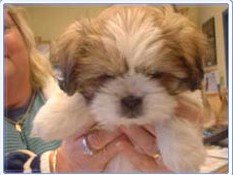 THE NEWBORNS
THE NEWBORNS The first 36 hrs of a puppies life is the critical period nutritionally. Healthy puppies will nurse right away and then every few hours. The pups must nurse from their mother within 12 hours of birth to receive her antibodies against disease. After 12 hours, their stomachs will not absorb antibodies. After this first 12 hours, if the mother does not have enough milk, or if her litter is too large, then the pups' diet can be supplemented with commercial puppy milk replacer. Cow's milk is nutritionally inadequate for puppies.
Supplemental heat should only be used for orphans or if the room's temperature is too cold for the mother's comfort. A newborn pup can't generate body heat until it develops the shiver reflex, at about two and half weeks of age. Orphan pups need an environmental temperature of about 97°F (36°C) the first week, in the mid 80's the second week, then in the 70's. If the mother is there to keep the pups warm, high temperatures are unnecessary and will make her uncomfortable.
If you have more than one puppy to raise, provide separate boxes and beds. With separate quarters you can monitor bowel eliminations and food intake.
Orphan puppies less than one week old must be stimulated to urinate and eliminate. This is accomplished by gentle massage of the abdomen and genital area with a piece of cotton wool or tissue, dampened with warm water.
HELPFUL HINTS -Aspirate the pups' throat and nostrils at birth
-Always pre-boil water and cool prior to using in formulas.
-A Healthy pup feels warm, and has a full belly of milk. He twitches and never lies perfectly still. (Activated sleep) - The muscles are getting stronger during activated sleep
-A Puppy in trouble will feel cold to the touch. Lays limp and refuses to nurse. This puppy needs your assistance in hope for survival.
-If you have another nursing mother you can give her the litter but you will still need to help her by bottle feeding or tube feeding the pups.
-Never feed a chilled puppy if a pup's temperature is below 94 degrees - they should NOT be nursing and you should NOT be tube feeding
-There is always the danger of a pup inhaling milk into its lungs and then getting pneumonia. Make sure your nipple hole is not too large or too small. Stick a hot paper clip in the nipple. Hold it upside down - the milk should drip out, but never flow.
-The pup may have little bubbles on the side of its lips, but the milk should not run out of the sides of the mouth.
-Encourage the pup by wiggling the nipple across his lips.
-Burp puppies after feeding, to reduce any gas they may have.
-You will know if he is getting the milk by measuring the amount in the bottle and after burping can you see if he has a full belly or if he needs more.
-Calorie and fluid intake must be adjusted so puppies consume adequate formula to meet nutrient needs for growth, but not over or under consume fluid volume.
Making up formulas and feeding a litter of puppies is very time consuming. It seems like as soon as you're finished, its time to begin again.
To find more information click
here






